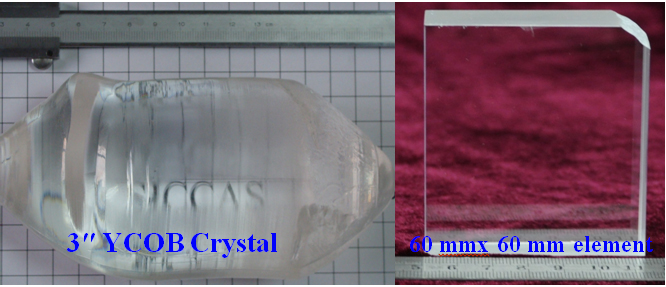SICCAS fabricated YCOB non-linear optical element with aperture of 60 mm×60 mm
YCa4O(BO3)3(referred to as YCOB)crystal was invented in 1996 by Aka et al of French National Center for Scientific Research. Later, it attracted new attention after researchers found that YCOB had excellent non-linear optical properties, high temperature piezoelectric properties and good chemical stability. Compared with another non-linear optical crystal LiB3O5 (LBO) which was commonly used in high power laser system, YCOB has many advantages as follows: firstly, this crystal is not deliquescence; secondly, its non-linear optical coefficients are 37.5% larger than that of the former; thirdly, its temperature acceptance is 22 times wider; fourthly, although its laser-induced damage threshold is similar to the former, parametric fluorescence is three orders lower; finally, the machinability of YCOB is better with less anisotropy and one order lower of thermal expansion coefficient. YCOB crystal can be grown by Czochralski method, so large aperture YCOB non-linear optical element for high power laser could be fabricated at low cost because of short growth cycle. YCOB non-linear optical elements with large aperture can be used as SHG, THG, OPO, OPA and OPCPA crystals in high energy and high power laser system.
Study on YCOB crystal growth began in 2010 funded by National 863 Project. The efforts that were made to solve the problem of raw material synthesis and polycrystalline growth, explore suitable temperature field, have led to the successful growth of high quality YCOB crystal, size of which was one inch in the year of 2010 by researchers from Shanghai Institute of Ceramics, Chinese Academy of Sciences (SICCAS). At the end of 2010, two inches YCOB crystal was successfully grown. Three month later, YCOB crystal was fabricated with diameter larger than three inches. YCOB crystal which was free of crack and inclusion was obtained in June of 2011, after having overcome several growth defects, such as crystal cleavage, inclusions, growth striations and so on. The experimental tests showed that its optical homogeneity Δn was 2.0×10-5. Non-linear optical element with aperture of 60mm×60mm was cut from the YCOB boule, and had been successfully applied to joule-level and broadband non-collinear optical parametric chirped-pulse amplification centered at 800 nm. Based on a Ti:sapphire chirped-pulse amplification front end, an amplified signal energy of 3.36 J was generated with a pump of 35 J in the crystal. Compressed pulse duration of 44.3 fs, with a bandwidth of 49 nm, was achieved. The results confirm that YCOB crystal is another potential alternative as a final amplifier besides Ti:sapphire in a petawatt laser at 800 nm (published in Optical Letters 37(2012)1712 ).
In addition, the YCOB crystal is also a kind of excellent piezoelectric material which can be used under harsh environment. The biggest advantage is that YCOB crystal has no phase transition from room temperature to its melting point, so its piezoelectric activity can be kept to the melting point. Moreover, its electrical resistivity under high temperature environment is ultra-high, being the highest one ever reported. The electrical resistivity is up to 2.0×108 Ω·cm at 800℃, and exceeds 1.0×107 Ω·cm at 1000℃. Piezoelectric devices fabricated by YCOB crystal can be used as vibration monitor devices in engines of spaceflight or aviation under temperature up to 1000℃.
Shanghai SICCAS High Technology Corporation (www.siccas.com) can provide large aperture high quality YCOB non-linear optical elements and piezoelectric elements to users at various fields from now on.

Fig.1 The YCOB crystal with 3 inches diameter and element with aperture of 60 mm X 60 mm



